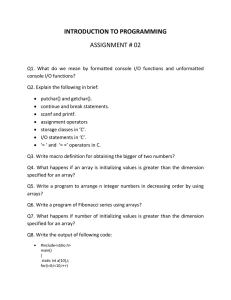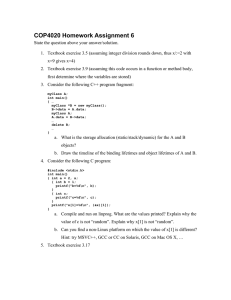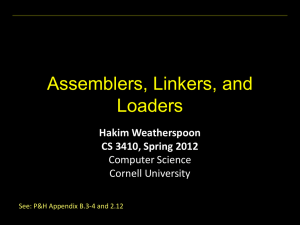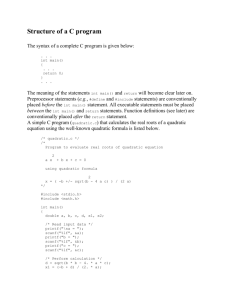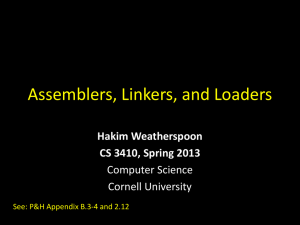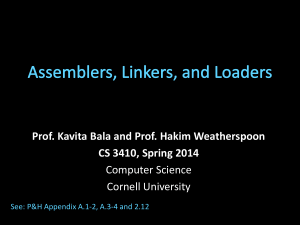Assemblers, Linkers, and Loaders Hakim Weatherspoon CS 3410, Spring 2013 Computer Science
advertisement
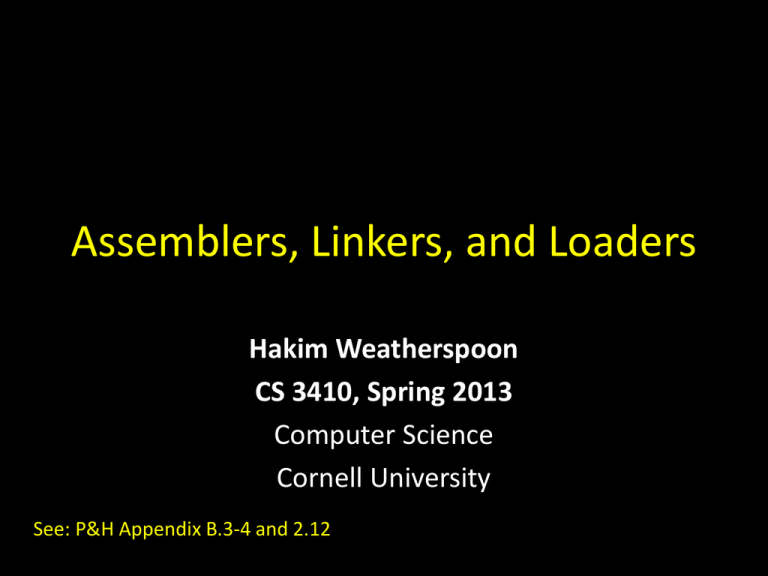
Assemblers, Linkers, and Loaders
Hakim Weatherspoon
CS 3410, Spring 2013
Computer Science
Cornell University
See: P&H Appendix B.3-4 and 2.12
Goal for Today: Putting it all Together
Review Calling Convention
Compiler output is assembly files
Assembler output is obj files
Linker joins object files into one executable
Loader brings it into memory and starts execution
Recap: Calling Conventions
•
•
•
•
first four arg words passed in $a0, $a1, $a2, $a3
remaining arg words passed in parent’s stack frame
return value (if any) in $v0, $v1
$fp
stack frame at $sp
– contains $ra (clobbered on JAL to sub-functions)
– contains $fp
– contains local vars (possibly
clobbered by sub-functions)
– contains extra arguments to sub-functions
(i.e. argument “spilling)
– contains space for first 4 arguments to sub-functions
• callee save regs are preserved
• caller save regs are not
• Global data accessed via $gp
$sp
saved ra
saved fp
saved regs
($s0 ... $s7)
locals
outgoing
args
Warning: There is no one true MIPS calling convention.
lecture != book != gcc != spim != web
MIPS Register Conventions
r0
r1
r2
r3
r4
r5
r6
r7
r8
r9
r10
r11
r12
r13
r14
r15
$zero
zero
$at assembler temp
$v0
function
return values
$v1
$a0
$a1
function
arguments
$a2
$a3
$t0
$t1
$t2
$t3
temps
$t4
(caller save)
$t5
$t6
$t7
r16
r17
r18
r19
r20
r21
r22
r23
r24
r25
r26
r27
r28
r29
r30
r31
$s0
$s1
$s2
$s3
$s4
$s5
$s6
$s7
$t8
$t9
$k0
$k1
$gp
$sp
$fp
$ra
saved
(callee save)
more temps
(caller save)
reserved for
kernel
global data pointer
stack pointer
frame pointer
return address
Anatomy of an executing program
0xfffffffc
top
system reserved
0x80000000
0x7ffffffc
stack
dynamic data (heap)
0x10000000
0x00400000
0x00000000
static data
.data
code (text)
.text
system reserved
bottom
Anatomy of an executing program
+4
alu
D
D
A
$0 (zero)
$1 ($at)
register
file
$29 ($sp)
$31 ($ra)
memory
addr
Instruction
Decode
Instruction
Fetch
IF/ID
ctrl
detect
hazard
ID/EX
forward
unit
Execute
M
Stack, Data, Code
Stored in Memory
EX/MEM
Memory
ctrl
new
pc
dout
memory
ctrl
extend
din
B
control
imm
inst
PC
compute
jump/branch
targets
B
Code Stored in Memory
(also, data and stack)
WriteBack
MEM/WB
Takeaway
We need a calling convention to coordinate use of
registers and memory. Registers exist in the
Register File. Stack, Code, and Data exist in
memory. Both instruction memory and data
memory accessed through cache (modified harvard
architecture) and a shared bus to memory (Von
Neumann).
Next Goal
Given a running program (a process), how do we
know what is going on (what function is executing,
what arguments were passed to where, where is
the stack and current stack frame, where is the
code and data, etc)?
Activity #1: Debugging
init():
0x400000
printf(s, …): 0x4002B4
vnorm(a,b): 0x40107C
main(a,b): 0x4010A0
pi:
0x10000000
str1:
0x10000004
What func is running?
Who called it?
Has it called anything?
Will it?
Args?
Stack depth?
Call trace?
CPU:
$pc=0x004003C0
$sp=0x7FFFFFAC
$ra=0x00401090
0x00000000
0x0040010c
0x7FFFFFF4
0x00000000
0x00000000
0x00000000
0x00000000
0x004010c4
0x7FFFFFDC
0x00000000
0x00000000
0x00000015
0x7FFFFFB0 0x10000004
0x00401090
Compilers and Assemblers
Next Goal
How do we compile a program from source to
assembly to machine object code?
Big Picture
Compiler output is assembly files
Assembler output is obj files
Linker joins object files into one executable
Loader brings it into memory and starts execution
Example: Add 1 to 100
int n = 100;
int main (int argc, char* argv[ ]) {
int i;
int m = n;
int sum = 0;
for (i = 1; i <= m; i++)
count += i;
printf ("Sum 1 to %d is %d\n", n, sum);
}
export PATH=${PATH}:/courses/cs3410/mipsel-linux/bin:/courses/cs3410/mips-sim/bin
or
setenv PATH ${PATH}:/courses/cs3410/mipsel-linux/bin:/courses/cs3410/mips-sim/bin
# Assemble
[csug03] mipsel-linux-gcc –S add1To100.c
Example: Add 1 to 100
.data
.globl
.align
n:
.word
.rdata
.align
$str0: .asciiz
"Sum
.text
.align
.globl
main: addiu
sw
sw
move
sw
sw
la
lw
sw
sw
li
sw
n
2
100
$L2:
2
1 to %d is %d\n"
2
main
$sp,$sp,-48
$31,44($sp)
$fp,40($sp)
$fp,$sp
$4,48($fp)
$5,52($fp)
$2,n
$2,0($2)
$2,28($fp)
$0,32($fp)
$2,1
$2,24($fp)
$L3:
lw
lw
slt
bne
lw
lw
addu
sw
lw
addiu
sw
b
la
lw
lw
jal
move
lw
lw
addiu
$2,24($fp)
$3,28($fp)
$2,$3,$2
$2,$0,$L3
$3,32($fp)
$2,24($fp)
$2,$3,$2
$2,32($fp)
$2,24($fp)
$2,$2,1
$2,24($fp)
$L2
$4,$str0
$5,28($fp)
$6,32($fp)
printf
$sp,$fp
$31,44($sp)
$fp,40($sp)
$sp,$sp,48
Example: Add 1 to 100
# Assemble
[csug01] mipsel-linux-gcc –c add1To100.s
# Link
[csug01] mipsel-linux-gcc –o add1To100 add1To100.o
${LINKFLAGS}
# -nostartfiles –nodefaultlibs
# -static -mno-xgot -mno-embedded-pic
-mno-abicalls -G 0 -DMIPS -Wall
# Load
[csug01] simulate add1To100
Sum 1 to 100 is 5050
MIPS program exits with status 0 (approx. 2007
instructions in 143000 nsec at 14.14034 MHz)
Globals and Locals
Variables
Visibility
Lifetime
Location
Function-Local
Global
Dynamic
int n = 100;
int main (int argc, char* argv[ ]) {
int i, m = n, sum = 0, *A = malloc(4 * m);
for (i = 1; i <= m; i++) { sum += i; A[i] = sum; }
printf ("Sum 1 to %d is %d\n", n, sum);
}
Globals and Locals
Variables
Visibility
Lifetime
Function-Local
w/in func
func
invocation
stack
whole prgm
prgm
execution
.data
Anywhere that b/w malloc
C Pointers can be trouble has a ptr and free
heap
i, m, sum
Global
n, str
Dynamic
A
Location
Example #2: Review of Program Layout
calc.c
vector* v = malloc(8);
v->x = prompt(“enter x”);
v->y = prompt(“enter y”);
int c = pi + tnorm(v);
print(“result %d”, c);
system reserved
stack
math.c
int tnorm(vector* v) {
return abs(v->x)+abs(v->y);
}
lib3410.o
global variable: pi
entry point: prompt
entry point: print
entry point: malloc
dynamic data (heap)
static data
code (text)
system reserved
Assembler
calc.c
math.c
C source
files
Compiler
calc.s
math.s
io.s
assembly
files
calc.o
math.o
io.o
libc.o
libm.o
obj files
Assembler
linker
executable
program
calc.exe
exists on
disk
loader
Executing
in
Memory
process
Next Goal
How do we understand the machine object code
that an assembler creates?
Big Picture
math.c
math.s
math.o
.o = Linux
.obj Windows
Output is obj files
• Binary machine code, but not executable
• May refer to external symbols i.e. Need a “symbol table”
• Each object file has illusion of its own address space
– Addresses will need to be fixed later
e.g. .text (code) starts at addr 0x00000000
.data starts @ addr 0x00000000
Symbols and References
Global labels: Externally visible “exported” symbols
• Can be referenced from other object files
• Exported functions, global variables e.g. pi
(from a couple of slides ago)
Local labels: Internal visible only symbols
• Only used within this object file
• static functions, static variables, loop labels, …
e.g.
static foo
static bar
static baz
e.g.
$str
$L0
$L2
Object file
Header
• Size and position of pieces of file
Text Segment
Object File
• instructions
Data Segment
• static data (local/global vars, strings, constants)
Debugging Information
• line number code address map, etc.
Symbol Table
• External (exported) references
• Unresolved (imported) references
math.c
Example
int pi = 3;
int e = 2;
static int randomval = 7;
extern char *username;
extern int printf(char *str, …);
int square(int x) { … }
static int is_prime(int x) { … }
int pick_prime() { … }
int pick_random() {
return randomval;
}
Objdump disassembly
csug01 ~$ mipsel-linux-objdump --disassemble math.o
math.o:
file format elf32-tradlittlemips
Disassembly of section .text:
00000000 <pick_random>:
0:
27bdfff8
addiu
4:
afbe0000
sw
8:
03a0f021
move
c:
3c020000
lui
10:
8c420008
lw
14:
03c0e821
move
18:
8fbe0000
lw
1c:
27bd0008
addiu
20:
03e00008
jr
24:
00000000
nop
00000028 <square>:
28:
27bdfff8
2c:
afbe0000
30:
03a0f021
34:
afc40008
addiu
sw
move
sw
sp,sp,-8
s8,0(sp)
s8,sp
v0,0x0
v0,8(v0)
sp,s8
s8,0(sp)
sp,sp,8
ra
sp,sp,-8
s8,0(sp)
s8,sp
a0,8(s8)
Objdump symbols
csug01 ~$ mipsel-linux-objdump --syms math.o
math.o:
file format elf32-tradlittlemips
SYMBOL TABLE:
00000000 l
00000000 l
00000000 l
00000000 l
00000000 l
00000008 l
00000060 l
00000000 l
00000000 l
00000000 g
00000004 g
00000000 g
00000028 g
00000088 g
00000000
00000000
df
d
d
d
d
O
F
d
d
O
O
F
F
F
*ABS*
.text
.data
.bss
.mdebug.abi32
.data
.text
.rodata
.comment
.data
.data
.text
.text
.text
*UND*
*UND*
00000000
00000000
00000000
00000000
00000000
00000004
00000028
00000000
00000000
00000004
00000004
00000028
00000038
0000004c
00000000
00000000
math.c
.text
.data
.bss
.mdebug.abi32
randomval
is_prime
.rodata
.comment
pi
e
pick_random
square
pick_prime
username
printf
Separate Compilation
Q: Why separate compile/assemble and linking steps?
A: Can recompile one object, then just relink.
Takeaway
We need a calling convention to coordinate use of
registers and memory. Registers exist in the Register
File. Stack, Code, and Data exist in memory. Both
instruction memory and data memory accessed
through cache (modified harvard architecture) and a
shared bus to memory (Von Neumann).
Need to compile from a high level source language to
assembly, then assemble to machine object code. The
Objdump command can help us understand structure
of machine code which is broken into hdr, txt and
data segments, debugging information, and symbol
table
Linkers
Next Goal
How do we link together separately compiled and
assembled machine object files?
Big Picture
calc.c
calc.s
calc.o
math.c
math.s
math.o
io.s
calc.exe
io.o
libc.o
libm.o
linker
Executing
in
Memory
Linkers
Linker combines object files into an executable file
• Relocate each object’s text and data segments
• Resolve as-yet-unresolved symbols
• Record top-level entry point in executable file
End result: a program on disk, ready to execute
• E.g.
./calc
./calc.exe
simulate calc
Linux
Windows
Class MIPS simulator
Linker Example
Relocation info Symbol tbl
.text
main.o
...
0C000000
21035000
1b80050C
4C040000
21047002
0C000000
...
00 T
main
00 D
uname
*UND* printf
*UND* pi
40, JL, printf
4C, LW/gp, pi
54, JL, square
math.o
...
21032040
0C000000
1b301402
3C040000
34040000
...
20 T square
00 D pi
*UND* printf
*UND* uname
28, JL, printf
30, LUI, uname
34, LA, uname
printf.o
...
3C T
printf
Linker Example
main.o
...
0C000000
21035000
1b80050C
4C040000
21047002
0C000000
...
calc.exe
math.o
2
00 T
main B
00 D
uname
*UND* printf
*UND* pi
40, JL, printf
4C, LW/gp, pi
54, JL, square
...
21032040
0C000000
1b301402 1
3C040000
34040000
...
20 T square
A
00 D pi
*UND* printf
*UND* uname
28, JL, printf
30, LUI, uname
34, LA, uname
printf.o
...
3C T
printf
3
...
21032040
0C40023C
1b301402 1
3C041000
34040004
...
0C40023C
21035000
1b80050c 2
4C048004
21047002
0C400020
...
10201000
21040330 3
22500102
...
uname 00000003
pi
0077616B
Entry:0040 0100
text:0040 0000
data:1000 0000
Object file
Header
• location of main entry point (if any)
Text Segment
Object File
• instructions
Data Segment
• static data (local/global vars, strings, constants)
Relocation Information
• Instructions and data that depend on actual
addresses
• Linker patches these bits after relocating segments
Symbol Table
• Exported and imported references
Object File Formats
Unix
•
•
•
•
a.out
COFF: Common Object File Format
ELF: Executable and Linking Format
…
Windows
• PE: Portable Executable
All support both executable and object files
Recap
Compiler output is assembly files
Assembler output is obj files
Linker joins object files into one executable
Loader brings it into memory and starts execution
Administrivia
Upcoming agenda
• Schedule PA2 Design Doc Mtg for next Monday, Mar 11th
• HW3 due next Wednesday, March 13th
• PA2 Work-in-Progress circuit due before spring break
• Spring break: Saturday, March 16th to Sunday, March 24th
• Prelim2 Thursday, March 28th, right after spring break
• PA2 due Thursday, April 4th
